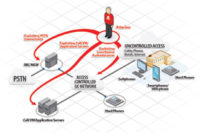The Upside of Upkeep


|
|
Third party security monitoring can provide a level of outsourced video service and maintenance. Pictured: G4S Wackenhut goes “live” with its security monitoring and data center. |
There are more than 4,300 security video cameras in the Big Apple’s busy subway system. But after an investigation last year of a violent stabbing attack lacking any images for follow up, the Metropolitan Transportation Authority (MTA) took inventory and discovered that about half of them did not work, or recording was faulty, or the lens or dome was dirty or spray painted, or the field of view had changed and the cameras not. Or a million other reasons with the bottom line being that – even before installation – security video needs reasonable service and maintenance at the camera, through transmission and recording, with the software and monitoring.
It turns out that when New York Mayor Michael Bloomberg would take the R train at his City Hall station, video recording even from those cameras did not work.
Such problems, unfortunately, are common across all types of enterprises and agencies.
Since today’s security video components, software and systems are more like (or are) high-end computer and communications systems, the expectation is that, if the system starts up, it will run forever or until Microsoft comes out with a new operating system. Don’t fall for the expectation, however. Jim Henry of industry-influential Henry Brothers, the New York-based integrator, points out that expectations are among his greatest challenges. “Clients may have higher expectations than what the technology can deliver; or their expectations may not meet their budget.”
So it is with service and maintenance, too.
Jay Haughn, ADT Security Service’s chief technical officer, agrees, noting that today’s electronic equipment is very reliable. There are hardware warranties. And maintenance contracts cover the hardware and labor. Now security video cameras are an IT appliance. They have the ability to monitor themselves, to some degree.
There are still maintenance expectations that need addressing, says Haughn. Digital video recorders (DVRs) get hot inside and a fan could die suddenly. DVRs will fail sooner or later, he notes. Cameras can go out of focus or the camera view can change. What do you do when some things fail? He says that the quick availability of spare parts and extra components on the shelf, either at the enterprise site or through a responsive integrator or dealer, will lessen downtime.
Installation Outpaces Maintenance
The MTA threw up thousands of cameras in its subway system but may have been less focused on service and maintenance issues. In addition, as the economy went south of the Bowery, there were fewer dollars for upkeep and less people to keep an eye on the equipment.
Cloud computing may be an emerging way to keep up with video gear, software advances and other similar issues. One answer to service and maintenance is a managed service platform, adds Haughn. But it is not for everyone. He suggests that “in the cloud” makes the most business sense now for large enterprises with hundreds locations with a few cameras each.
Enterprise security leader frustrations can also diminish by understanding the industry’s licensing models. “Keep it simple,” says Mark Holtenhoff, CEO of Aimetis, the video management and video analytics firm. And make service and maintenance easier through the flexibility of open platform standards.
No doubt, everyone’s security video system is essential to keep up and running. Still, there are some installations that are more essential than others. For instance, the jail in Wayne County, N.Y., has a networked video system that corrections officers use to view video in real-time to track movements or look for inmate movement and activity. Video is also used after the fact to investigate alleged incidents or to provide evidence for an inmate hearing.

|
|
Look at the expertise and certifications of outsourced service and maintenance personnel, according to Matthew Ladd of the Protection Bureau, a Security-Net member. |
Video surveillance at the jail, built around OnSSI’s open architecture video-centric physical security information management (PSIM), must consistently work on the local area network for display, video clips and other uses. The new technology went for a simpler approach, yet with the ability of the operator to zoom in electronically for a larger image on any monitor.
Maintaining an effective security video system also brings dollars down to the bottom line. “I can’t put an exact number on what the system has saved us dollar-wise, but I can tell you that instead of spending days on an allegation against an inmate or a staff member, we can refute the claim in a matter of minutes,” comments Wayne County Sheriff’s Office Major Lester Carr.
Installing the new system involved merging the best of new technologies with existing analog cabling infrastructure at the jail, thus providing the best of the old and the new as well as underlining the importance of service and maintenance in both worlds. “The exciting thing is that this is an occasion when government worked together seamlessly to get the job done,” adds Wayne County Sheriff Virts. “A multidisciplinary team including the IT department, buildings and grounds, the Sheriff’s Office and the vendor would meet weekly for status updates.”
Moving to the new design also addressed the older technology’s maintenance problems. Because the original system was not scalable, multiple video technologies had been added on over the years as the jail was renovated and expanded with new additions. Many of the older cameras were not even working anymore. The surveillance upgrade was paid half by taxpayer dollars and half by jail revenue.
Off Shelf Eases Service Needs
PSIM now can incorporate various camera models and other off-the-shelf hardware into an advanced, intuitive and unified client application to access a variety of video and event information.
Training is yet another element within a solid service and maintenance plan. Training has been easy at the jail, points out Carr, and there have been very few questions about how the system works. “I have watched them use it, and the corrections officers operating the system can make the system dance. When you put in a system of this magnitude, you expect to have months of questions and user errors, but we had very little of that when we turned on the system.”
Beyond standard service and maintenance contracts, some buyers move closer to their integrators through this critical area.
Upping the Upkeep Requirements
Jason Oakley, CEO, North American Video, points out that “service and maintenance agreements are an important market segment and constitute a growing piece of our portfolio. Technology is becoming more complex, and one result is that service and maintenance agreements are even more important as a way to maximize ongoing system efficiency. As leaders in the customer’s IT department take a greater role in choosing technology, the importance of service and software support agreements is increasing; these agreements are a familiar and common expectation in the IT arena. Service and software support is an extension of system maintenance and among the more critical services.”
Oakley firmly believes that ongoing service and maintenance lowers the total cost of system ownership in a number of ways:
|
• To ensure that latest versions of software and firmware are deployed • To provide preventative maintenance to prolong system life and minimize the need for emergency service • To implement data backup and validation • To allow for accurate, predictable budgeting and to avoid unexpected costs • Fewer in-house costs related to personnel and training (because service is outsourced) |
Oakley adds that good service and maintenance agreements can help “foster productive long-term client relationships that are based on customer service, expertise and operational excellence. Service business is also critical for systems integrators as a way to provide a steady revenue stream with less dependence on large projects. However, service business requires integrators to invest heavily in technical training, infrastructure and processes in order to deliver high-quality service.”
Oakley says that, when it comes to service and maintenance, “the degree of outsourcing depends on the overall strategy of the client. The extent of the role of the end user is largely dependent on the availability of qualified technical resources. Some of our clients undertake some tasks themselves; others completely outsource system maintenance and support.” Economically, outsourcing such tasks “could be the less expensive approach in the long run.”
Looking for a reprint of this article?
From high-res PDFs to custom plaques, order your copy today!








